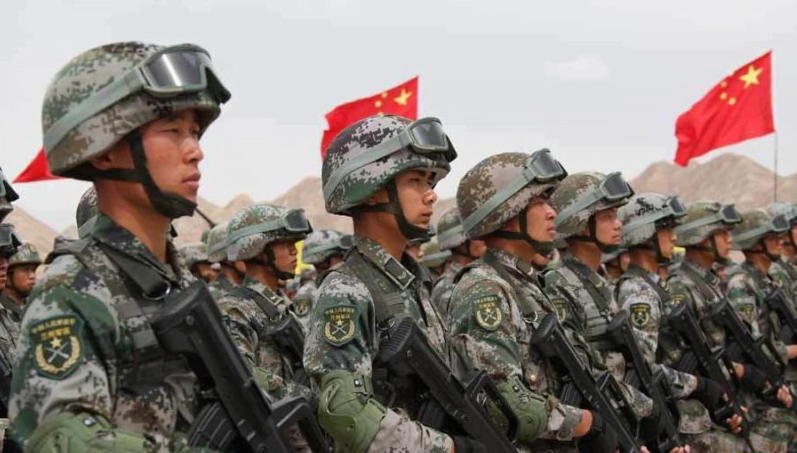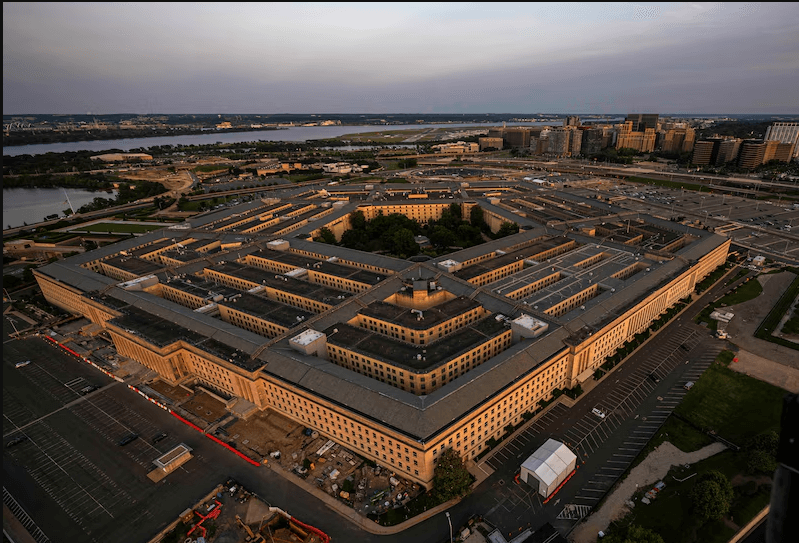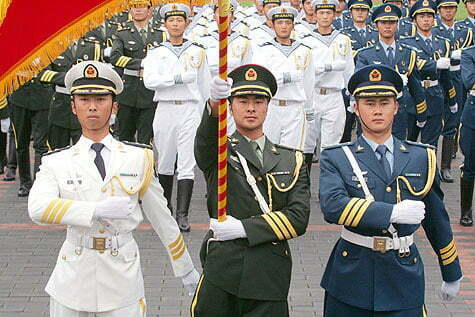What does China’s military city mean for India and the World?

China is building what is going to be the world’s largest military complex — ten times the size of the Pentagon – about 30 kilometres southwest of Beijing.
This highly secret military complex informally called as the “Beijing Military City,” spread over nearly 1,500 acres, is expected to be ready for all conceivable dimensions of AI-driven or nuclear wars in future. The facility equipped to serve as the nerve centre for satellite coordination and cyber defence/offense during military operations will allow Beijing to shorten decision-making cycles and act with precision in any regional contingency, in the Himalayas or the Indian Ocean.
The construction began in mid-2024, and the facility is expected to be operational by 2027– coinciding with the 100th anniversary of the People’s Liberation Army (PLA). This timeline is very important considering the fact that Xi Jinping has been repeatedly stressing on the importance of turning the PLA into a “world-class force” by this centenary.

The construction of the Beijing Military City, ten times larger than the Pentagon is more than just a physical expansion of infrastructure — it is a powerful signal of China’s strategic ambition to dominate future wars, from AI-driven conflicts to nuclear showdowns.
Also Read: Behind Closed Doors: Pentagon the fortress of the U.S. military
U.S. intelligence analysts believe that the Beijing Military Complex may replace the existing Western Hills command centre as China’s primary wartime headquarters and serve as a central hub for the People’s Liberation Army (PLA), integrating various military branches and enhancing China’s strategic command capabilities.

Unlike most of the existing military command centre worldwide, the Beijing Military Complex will reportedly have self-sufficient city infrastructure including living quarters, medical facilities, logistics hubs, and even recreational amenities—so that people could operate independently for extended periods.
The ultra-modern Beijing Military complex – is being designed to have deep underground bunkers, command centres and tunnels to protect China’s top military leadership during war and peace.
The command centre equipped with the latest paraphernalia is expected to assist human commanders analyse battlefield real-time data, take informed decisions and reduce response time significantly with the help of AI-enabled command, control, communication and intelligence systems.

The facility is being designed and developed as an integrated command centre and joint operations hub for all the People’s Liberation Army’s (PLA) five branches, names —the Ground Force, Navy, Air Force, Rocket Force (strategic missiles), and Strategic Support Force (cyber, space, and electronic warfare). Recently, the Strategic Support Force has been restructured, and the PLA now has four service branches and four independent arms including:
Four Service Branches:
- PLA Army (Ground Force): The main land-based force.
- PLA Navy: The maritime force, including surface ships, submarines, and naval aviation.
- PLA Air Force: The air force, responsible for aerial operations.
- PLA Rocket Force: The strategic missile force.
Four Independent Arms:
- Aerospace Force: Responsible for space-based operations.
- Cyberspace Force: Responsible for cyber warfare and information security.
- Information Support Force: Responsible for electronic warfare and psychological operations.
- Joint Logistics Support Force: Provides logistical support to the PLA
How does Beijing Military City compare with other global military complexes?
| Category | China (Beijing Military City) | USA (Pentagon + Global Commands) |
| Scale | 1,500 acres, largest globally | 150 acres + global network |
| Nuclear Command | Hardened bunkers, strategic focus | Advanced, secure triad system |
| AI and Cyber Integration | Heavy investment, integrated warfare focus | Global leader (AI/Cyber Command, NSA) |
| Space Command | Rapid expansion, ASAT tested | Dominant, global coverage |
| Global Power Projection | Limited bases, growing ambition | Unrivaled global base network |
| Active Troops | ~2 million | ~1.4 million |
Significance of 2027 for PLA:

The PLA traces its origin to the Nanchang Uprising on August 1, 1927, when communist forces led by Zhu De, Zhou Enlai, and others revolted against the Kuomintang (KMT) government. Since that day August 1 is celebrated every year as PLA Day in China. In 2027, the PLA will complete 100 years of existence — which is that year is symbolically important in China’s military roadmap.
By 2027, Chinese President Xi Jinping has called for the PLA to become a fully modernized force capable of fighting and winning wars — part of his vision to make China a “world-class military” by 2049 (the centenary of the People’s Republic of China).
The timeline aligns with China’s ambitions to:
- Complete military mechanization.
- Accelerate AI-driven warfare capabilities.
- Enhance nuclear deterrence and command infrastructure
- Prepare for contingencies in hotspots like Taiwan, South China Sea, and potentially beyond.

In due course, the Beijing Military City is expected to surpass the Pentagon – the most experienced battle-tested command structure and iconic military command centre in the world at present, in terms of scale, modernization, and integration.
The development of the Beijing Military City aligns with China’s broader military modernization efforts. Analysts view this project as a significant step in China’s ambition to bolster its military infrastructure and assert its position on the global stage.
While the Chinese government has not officially acknowledged the existence of the Beijing Military City, the scale and secrecy surrounding the project have raised concerns among international observers. The facility’s construction is seen as a reflection of China’s strategic priorities and its focus on enhancing national defence capabilities in the face of evolving global security dynamics.
China’s construction of the Beijing Military City represents a significant development in global military infrastructure, reflecting its strategic ambitions and prompting neighbouring countries, including India, to evaluate and adapt their defence strategies accordingly.
PLA vs Major Militaries (2025)

| Category | China (PLA) | United States (US Military) | Russia (Russian Armed Forces) | India (Indian Armed Forces) |
| Active Personnel | ~2 million (largest globally) | ~1.3 million | ~1 million | ~1.45 million |
| Defense Budget (2025 est.) | ~$230 billion | ~$860 billion | ~$110 billion | ~$75 billion |
| Nuclear Warheads | ~500+ (modernizing rapidly) | ~5500 (highest globally) | ~4000 | ~170-200 |
| Aircraft Carriers | 3 (Fujian under trials) | 11 active, 2 building | 1 (Admiral Kuznetsov, under repair) | 2 active (INS Vikramaditya, INS Vikrant) |
| 5th Gen Fighters | J-20 (~200+ in service) | F-22 (~120), F-35 (~900+) | Su-57 (limited, ~20) | AMCA under development (no operational 5th gen yet) |
| Hypersonic Weapons | DF-17 operational | Hypersonic glide vehicle (HGV) testing | Avangard operational, Kinzhal deployed | No operational hypersonic missile yet |
| Space/ASAT Capability | ASAT missile tested 2007, developing co-orbital weapons | Advanced space command, ASAT capability | ASAT capability confirmed | ASAT tested (Mission Shakti, 2019) |
| Cyber and EW | PLASSF fully operational | Cyber Command operational | Cyber capability proven but limited global reach | Defence Cyber Agency established, improving |
| Global Military Bases | Djibouti, rumored plans in Pakistan/Cambodia | 750+ overseas bases | Few bases (Syria, Arctic presence) | No overseas bases |
Implications for India

The emergence of the Beijing Military City poses strategic challenges for India.
The new facility, with its AI-enabled joint command structure, could offer China significant decision-making advantages to China in the Indo-Pacific region.
India will be compelled to accelerate its own plans for integrated Theatre Commands to match China’s capability of seamless joint operations. India, still has some catching up to do in integrated command and cyber warfare readiness.
The hardened bunkers and expanded missile command capabilities will strengthen China’s nuclear deterrent, potentially complicating strategic stability in Asia.
To offset Chinese advantages, India may need to deepen security partnerships through forums like the Quad and continue developing military ties with nations like the US, Japan, and Australia.
Conclusion:

The construction of the Beijing Military City is more than just another infrastructure project. It reflects a shift in global military thinking—toward deep integration of AI, cyber, nuclear, and space warfare into command structures. For China, this facility will symbolize its ambition to become a peer competitor to the United States and a dominant regional power in Asia.
For India, it is a clarion call to expedite defence modernization, build resilient command structures, and adopt emerging technologies. The road ahead requires tough choices, sustained investments, and strategic clarity.
China is not just preparing for the next war. It is preparing to win it before it even starts.

